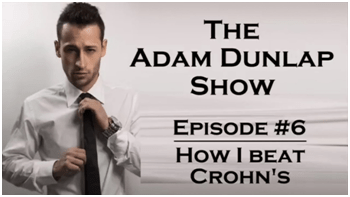Last update: 02-03-24
By Eugene L. Heyden, RN
Adam was 18 years old when he received the diagnosis of Crohn’s. He remembers the very day—December 23, 2004. Today, Adam is 30 and counting, free of Crohn’s now for over 8 years (and counting). This is his story:
Prior to his diagnosis, Adam had been ill, off and on, for approximately 10 months—with the occasional bloody stool and adnominal cramping that came and went. And to the doctor he came and went, multiple times. Indeed, he saw several different physicians, until one came to the realization “we better get to the bottom of things.” Of course, getting to the bottom of things meant a colonoscopy. Suspicions gave way to evidence; the diagnosis of Crohn’s was now an easy one to make.
With faithful use of prednisone and Asacol (and whatever), Adam soon returned to “normal.” Prednisone was tapered off, Asacol use continued, his health steadily improved . . . until it didn’t. Later in the year, 2005, Adam had a major disease flare that landed him in the hospital. His Crohn’s had become complicated by abscess formation. But thanks to the miracle of modern medicine, Adam gradually improved—so much so that his health was stable enough to follow through on his plan to study abroad. He left for Mexico in August, 2005, at the age of 19.
As we all know, Mexico is the land of abdominal cramping. And, sure enough, while in Mexico, Adam’s symptoms again came and went. Overall, during his four months stay in Mexico, he described his health as “rocky.” Even though he faithfully continued his Asacol, Adam experienced two major “flares,” one of which landed him in the hospital. Yes, it was a struggle, and thanks to a much-anticipated visit from Mom, and the supply of Asacol she brought, Adam was still able to complete his study abroad.
After returning from Mexico, Adam’s health generally stabilized. A year and a half after returning home, and a few flares later, he graduated from college with a degree in Business and a minor in Spanish. At this point in time, Adam was 21 years old. He was feeling pretty good about life and about his health, and faithfully continued to take Asacol to control his symptoms . . . until six months after graduation.
In December 2007, three years following his initial diagnosis, Adam found himself becoming rapidly ill over a period of two days. On the evening of day two, he lost consciousness. His mom rushed him to the hospital. He was admitted and appropriately treated.
Three days later, after multiple I.V.’s to correct dehydration, along with aggressive steroid therapy to control his GI inflammation, Adam was once again on his feet. Feeling much better, he was well enough to be discharged from the hospital. But when he left, he left a changed man. He would continue taking this Crohn’s medication, believed to have been changed from Asasol to Pentasa, but he was determined to fight his disease in a different way.
While in the hospital, it dawned on Adam that the conventional route was not healing him, it was only buying time until the next time. Somewhere along the line, either during or shortly after his hospitalization, Adam realized that help may have been within his reach for the past three years. He remembered that soon after he received his Crohn’s diagnosis, his aunt (certain to be his favorite aunt) had given him a book. It was The Maker’s Diet, by Jordan Rubin. He decided it was time to read the book and began reading (the book). The Maker’s Diet made sense to him, so a decision was made. He was going to put it to the test. Within a matter of weeks after starting the diet, he felt great, so much so that he began weaning himself off of Pentasa—a new medication given to him upon his recent discharge from the hospital. For Adam, “feeling great” became a way of life. His symptoms of Crohn’s have never returned. He credits this primarily to The Maker’s Diet. In addition to his diet makeover, Adam took various dietary supplements and followed a healthy, physically active lifestyle.
During my interview with Adam, I learned several things that are clearly relevant to the story. I learned that Adam first started having GI symptoms at about age twelve, but nothing was persistent enough or severe enough to warrant medical attention—“they sorta just came and went.” This was probably the beginnings of what would develop into full-blown Crohn’s. I also learned that, at the time of diagnosis, he weighed only 108 pounds. For someone who was five foot ten, he was sooooo underweight. But after his Crohn’s was diagnosed and treatment began, Adam gained 25 pounds within a period of six months. During my interview with Adam, I learned one more thing worth sharing: The Maker’s Diet was, in his own words, “difficult to follow,” and he ate a lot of chicken (that was two things). But he persevered. And the rest is history.
Adam is so proud of his accomplishment; so glad to be Crohn’s free. Today, Adam eats what he wants, but generally practices a “natural diet.
Click on the image below and you can listen to Adam tell the story of Adam
More war stories (Click image to open)
If you would like me to tell your story, I can be reached at: info@impactofvitamind.com.
Copyright © 2016–2022 Eugene L. Heyden, RN
All Rights Reserved

DISCLAIMER: The book excerpts and articles featured on this website are offered solely for informational purposes. The information contained therein should be evaluated for accuracy and validity in the context of opposing data, new information, and the views and recommendations of a qualified health care professional, and not to be substituted for professional judgment and guidance or to provide a reason to neglect or delay appropriate medical care for self or for others. It is the reader and reader only who bears the responsibility for any actions that could be construed as being a response to the information presented. The statements and opinions expressed by the author or authors of the information provided on this website have not been reviewed or approved by the FDA or by any other authoritative body, nor is the author endorsing any product or specific therapy mentioned. The book excerpts, articles, statements, and opinions are offered to the reader to broaden his or her understanding of the issues discussed and to help identify options that may be suitable for the individual to pursue, on behalf of self or others, under approval and direction of a qualified physician or medical team member. All questions of a medical nature which arise from the book excerpts and articles available on this website should be directed at qualified health care professional.














